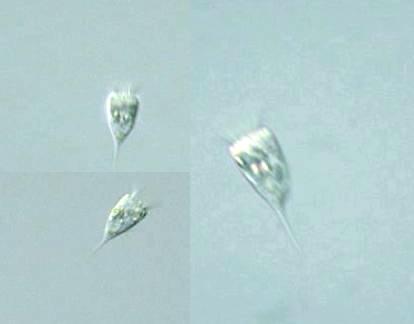

Spirotrichea:
Oligotrichia: Oligotrichida: Halteriidae
Strombidium caudatum
Fromentel, 1874
 Genus: Paratene makes nearly closed circle around body; ventral kinety often present
(Illustrated Guide, 1985).
Genus: Paratene makes nearly closed circle around body; ventral kinety often present
(Illustrated Guide, 1985).
Ovoid to spherical; adoral zone very conspicuous two to four conspicuous sickle-form frontal
membranellae, adoral membranellae extend down cytopharynx; no body bristles or cirri
(Kudo, 1966).
Body conical, ovoid or elongate posteriorly; somatic cilia absent; AZM composed of large membranelles
which emerge from the peristome and encircle the apex of the cell; polysaccharide plates or platelets
may conver and strengthen the posterior portion of the body (Carey, 1992).
Species:
Cell body ovoid, transparent, posterior end drawn out to form a caudal projection,
32 μm long
(An Illustrated Guide to Freshwater Zooplankton in Japan, 2000).
|
Similar Genus -> > Halteria
Strombidium . caudatum Fromentel, 1874 (or S. calkinsi 1902 ?),
cell body 35 μm long, 14 μm wide,
membranelles about 8 μm long,
x 400, x 640, Shiro-numa, Tatebayashi city, Gunma Pref., Japan, June 2001 by Y. Tsukii
 50 μm
50 μm
 100 μm
100 μm
 150 μm; x 400 :
150 μm; x 400 :
 31 μm
31 μm
 63 μm
63 μm
 94 μm; x 640
94 μm; x 640



Strombidium sulcatum
Claparède and Lachmann, 1858:
Ovoid, 60 μm long;
anterior bluntly pointed; AZM extends 1/3 the body length; posterior rounded;
the region of cortical platelets from the equatorial cleft to posterior end; a band of trichites presents
in this region (Carey, 1992).
Strombidium viridae Stein, 1867 (Syn. Strombidium nasutum Smith, 1897):
Conical, with a well-developed peristomial collar; rounded posterior;
80 μm long;
bundles of trichites make an equatorial band; posterior covered with polygonal cortical platelets;
macronucleus vermiform (Carey, 1992).
Please click on images for viewing enlarged.
Copyright
Protist Information Server
 Genus: Paratene makes nearly closed circle around body; ventral kinety often present
(Illustrated Guide, 1985).
Genus: Paratene makes nearly closed circle around body; ventral kinety often present
(Illustrated Guide, 1985).

